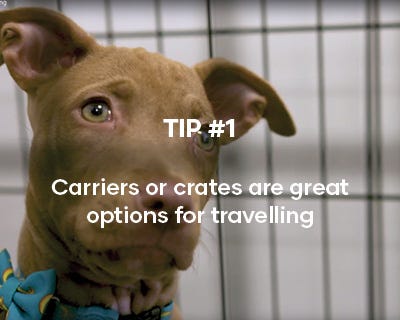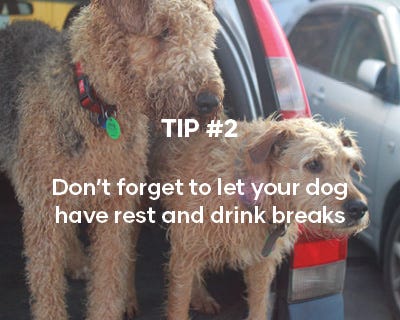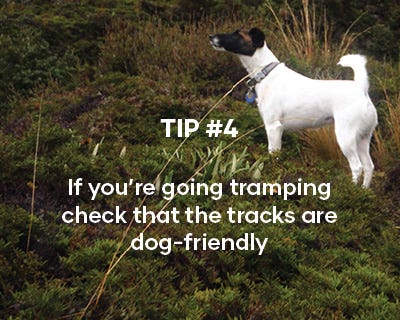Travelling with your dog
Travelling with your dog can be a short trip to your local clinic or the park, or as exciting as taking them on holiday with you. Wherever you’re going, it’s important to ensure your pet is safely restrained (in either a harness or a carrier), and can access what they need while you’re travelling.
Unfortunately, some pets do get travel-sickness, so preparing for this will not only make your pet’s travel less uncomfortable, but will also give you piece of mind.
Safety restraint options for your puppy
Having a properly restrained puppy while travelling is important for both their safety and yours. If a pet is left to wander in the car it can cause accidents as they may distract the driver, or if an accident occurs and if your puppy isn’t properly restrained they can end up seriously injured, just like if a human isn’t wearing a seatbelt. Invest in the best restraint options likely to avoid any accidents or injuries so you and your bestfriend can arrive from ‘A’ to ‘B’ safe and sound.
Carrier and crate Carriers/crates are great options for travelling. They keep your puppy in a safe, confined area where you can put a comfy bed/blanket for extra comfort. Carriers and crates need to be restrained while in the car ideally with a seatbelt.
Carriers/crates are great options for travelling. They keep your puppy in a safe, confined area where you can put a comfy bed/blanket for extra comfort. Carriers and crates need to be restrained while in the car ideally with a seatbelt.
When picking a suitable carrier/crate keep in mind your pup must be able to stand up and turn around in the carrier. If selecting one while your puppy is young, consider purchasing the right size for them as an adult too, this means you won’t need to purchase an additional carrier/crate as they grow. For some dogs, this may mean the carrier/crate is too large for your vehicle, in this case, we recommend a carrier for your puppy while they’re young, or a harness.
Chest plate harness
Chest plate harnesses in the car are a great way to keep your pet restrained, provided they’re used correctly. Some harnesses come with seatbelt attachments, otherwise it’s easy to buy an add-on for the car which provides the same safety. The harness needs to be snug around your dog’s body (with no more than two fingers of wiggle room) to ensure they cannot twist out and potentially injure themselves while you are moving. The seatbelt attachment then clips on to the D-ring of the harness, and buckles in to the seat belt buckle. This will allow your dog to sit, lie down – and not much more.
Never tie your dog in to your vehicle using their collar, if you have to stop suddenly this will put a lot of pressure on their necks, which can injure them. Likewise, having your pet restrained outside of the vehicle, such as in the tray of a ute, can result in serious injury to your pup (if they try to jump out, you have to stop suddenly or are involved in an accident . If travelling in the tray of the ute is inevitable, invest in a proper dog safety belt for the tray so they do not injure themselves, or use a secured crate.
Guards
Though not a form of restraint, these are great to use in conjunction with a harness, particularly if your pup will be restrained in the boot of your station wagon or 4WD. These guards fit to the headrests of the backseat, or from the floor to ceiling of the boot, and prevent your pet from moving. This is great if they try to jump into the backseat often, or if you have people sitting there who don’t need a friendly dog trying to sit on their laps.
Booster seats
Booster seats are great for smaller dogs as it allows them to sit up higher and comfortably see out the window and enjoy the view while safely confining them to one space, their own car seat. Booster seats are attached to the car seat usually with a strap which attaches to the head rest. Dogs will need to be strapped into the seat by attaching the seat’s tether to their chest plate harness.
Remember, restraining your pet in the vehicle is not only for the safety of your pet, but for your safety and those around you. Be responsible and invest in good restraint options, remembering that even as they grow they’ll need to be restrained as adults too.
Things to consider:
- How will you restrain your dog?
- If you’re going to use a carrier or crate try to get one that’s suitable for them as an adult so you don’t need to invest in one later.
- Guards are a great addition to travelling in the car with your puppy
- If your small pooch likes to look out the window, would a booster seat be the best option?
Car travel with your puppy (or dog)
Once you have selected how you’re going to restrain your pooch, it’s time to get them used to travelling in the car. Most dogs love travelling in the car, they’re out of the house, and they’re going somewhere fun. But for some pets, this can be stressful as they feel sick or are uncertain.
 Before any scheduled car trip, try to avoid feeding your dog. Travelling with a full stomach can increase the likelihood of sickness and make the ride less enjoyable. When travelling in your car with your pet, slow down and take corners easy.
Before any scheduled car trip, try to avoid feeding your dog. Travelling with a full stomach can increase the likelihood of sickness and make the ride less enjoyable. When travelling in your car with your pet, slow down and take corners easy.
Never leave your pet alone in a hot car, in particular during summer where the outside temperature can easily rise about 20 degrees Celsius. Pets become quickly overheated and may suffer from heat stroke, which can be deadly. Even during colder months, do not leave them alone in the car.
If you’re travelling further than you normally would don’t forget to let your dog have rest and drink breaks too. A dog that needs to go toilet can become anxious, so when you need to stop for a break, take your dog out on their lead and let them relieve themselves.
If your pet gets travel sick there are a few natural remedies you can try, such as Sedapet, Travel Well, or if these don’t work consider talking to your local Animates Vetcare who can offer you some advice on additional aids for car sickness.
Things to consider:
- Always take your dog out on an empty stomach if your dog gets car sick
- Where are you going? Vary your destinations so your pet doesn’t expect to always go to the vet
- Never leave your pet alone in a car on a hot day, heat stroke can be deadly
- Don’t forget to let your pet have toilet breaks too
- If travel sickness is an issue for your pet, look at what’s available over the counter, or talk to your local Animates Vetcare for more advice
Getting your dog used to their carrier/crate
Ensuring your dog is used to their carrier will make travel easier for both you, and them:
- Leave the carrier in the room your puppy frequents the most. If that’s the laundry, the living room or a bedroom, leave the carrier in a corner. This exposure will desensitise your dog to the presence of the carrier, which can be seen as a strange object to begin with.
- If your carrier is a standard, or airline, carrier, take the top off and put a blanket or mattress in it. By taking the top off the carrier, your puppy has a new bed which they will begin to use; when really it’s just the carrier.
- If your dog is still avoiding the carrier, try adding their toys in there, even their food or some treats to encourage them to go in.
- Once your dog seems comfortable going in and out of the carrier, put the lid on (but leave the door off).
- As your dog begins to go in and out of the enclosed space, praise them. Give them more treats, feed them in the carrier, do what you can to make them comfortable in their carrier.
- Eventually you will be able to put the door back on, and begin to leave your dog momentarily locked in the carrier. Don’t do this for long periods of time unless you’re travelling, this could scare your dog.
- With enough time, your dog will be happy and comfortable within their carrier/crate.
Flying with your dog
If you’re planning on taking your dog on a flight, always check with the airline to see what their rules are, each airline is different, so what works for one may be very different to another. If it’s a domestic flight your pet won’t need any special vaccines outside of their annual boosters, however if you’re travelling internationally it’s important you take the time to understand what’s required, this could be certain vaccinations, treatments or quarantine time, if unsure, contact your veterinarian and the airline who should be able to offer you advice.
 Regardless of how far you and your pet are flying, you’ll need an airline approved carrier. These are carriers that are bolted together, have air vents and they must be big enough for your dog to stand up, turn around, and lie down in. They’ll also need a secure bowl to have access to water. We recommend including your pets favourite bedding and a toy, to help them feel comfortable.
Regardless of how far you and your pet are flying, you’ll need an airline approved carrier. These are carriers that are bolted together, have air vents and they must be big enough for your dog to stand up, turn around, and lie down in. They’ll also need a secure bowl to have access to water. We recommend including your pets favourite bedding and a toy, to help them feel comfortable.
Always have clear documentation with your pets carrier, including your contact information and ‘LIVE PET’ written across their carrier. The more obvious, the better. This is precious cargo. If you’re worried about your pet's anxiety or risk of travel sickness, you can purchase over the counter treatments such as Sedapet to help calm your dog, or you may like to talk to your veterinarian for more information.
Things to consider:
- Always check with the airline you’re going on to see what rules they have with flying your dog.
- Ensure they're comfortable in their airline carrier.
- If travelling internationally, make sure you are aware of all the documentation, vaccinations or possible quarantine period they may need (both coming into the country and leaving).
- If you’re worried about your pet’s anxiety while on a flight, speak to your veterinarian and airline to see what is available.
Taking your puppy or dog on a boat/ferry
Sea travel is another way to travel with your dog. This could be on a boat, or on a ferry. Check with the ferry company you are using to see what their rules are, but often you will need to tell them you have a pet while booking. Some ferries will allow your dog to be on lead, but you may like to consider putting them in their carrier for additional safety.
Other ferries in New Zealand may require that your pet stays in your car. If this is the case, you will need to ensure it’s not too hot, the car windows are down and there is cold water available for them. If the day is hot, we recommend someone staying in the car, with the air conditioner on to help keep them cool.
If you’re not in a car on the ferry, they may take them to the kennels and safely secure them there. Either way, both the car hold and the kennels can be noisy, so ensure you have a comfy bed, a favourite toy, sedatives to help keep them anxiety-free if required.
When going on a boat, talk to the owner of the boat about their rules. Some pet owners with boats have fake grass available for dogs to relieve themselves on the boat, others may need your pet to wait until they’re on shore. Understanding this will better allow you to decide if taking your puppy on a boat is suitable. Don’t forget that your dog will need a life jacket too.
Things to consider:
- Know the rules of the ferry company you’re going to travel on. Book appropriately and make sure you have things available to keep your dog comfortable.
- If you’re going on a boat, talk to the owner of the boat about the rules for your dog, sometimes it may be more suitable to leave your them behind with a pet-sitter.
- If your dog is going to go on a boat, get a life jacket.
Travel destinations
Taking your dog on a trip is an exciting endeavour but make sure you have everything sorted out. If you’re staying in a motel/hotel always ensure they’re pet friendly. There are plenty around, and if you’re ever not sure, ask about their pet rules before making a booking. Make sure you take their crate with you when you go away on holiday, so they always have their home comforts with them.
 If you’re going to a campground make sure it’s a pet friendly one. Likewise, if you’re going tramping or hiking throughout New Zealand read the relevant Department of Conservation information that should tell you whether or not the tracks are dog-friendly. Remember, if they’re not dog-friendly, do not take your dog for their own safety as there will be bait, traps or New Zealand native wildlife that your dog could injure, startle, or scare away from nests. The rules are there for a reason, so follow them.
If you’re going to a campground make sure it’s a pet friendly one. Likewise, if you’re going tramping or hiking throughout New Zealand read the relevant Department of Conservation information that should tell you whether or not the tracks are dog-friendly. Remember, if they’re not dog-friendly, do not take your dog for their own safety as there will be bait, traps or New Zealand native wildlife that your dog could injure, startle, or scare away from nests. The rules are there for a reason, so follow them.
Always clean up after your pet, it’s a common courtesy, remember, the privilege of taking a pet to your holiday location can be revoked. Before you go travelling, make sure their registration and name tags are all up-to-date. If your pet gets lost, the easiest way to find you is via their name tag. If your pet loses their collar, this is when microchipping truly pays off. Before you leave town, pop into your local Animates store or Animates Vetcare and ask them to scan your pets microchip to make sure it’s still working okay, then jump on to the microchip registration website (www.animalregister.co.nz) to make sure your details are up to date – this will ensure you’re reunited to your pet quickly should anything go amiss.
Things to consider:
- Make sure any accommodation you book is pet friendly.
- If you’re going tramping or hiking, the tracks need to be dog-approved.
- Always clean up after your dog.
- Before you go on holiday ensure your pet’s council registration, name tag and microchip details are up to date.
Overview
Taking your pet on holiday with you is an exciting journey. Plan ahead and make sure all locations are pet-friendly, that you have their bed, crate, toys and food sorted, and that your contact details are up to date on your pets tags and microchip. If anything should go wrong while you’re away, look up and make an appointment with the vet local to the region and take your puppy in for a visit. There are lots of ways to enjoy travelling with your dog, so make the most of it and go see New Zealand (or beyond) with your dog.















